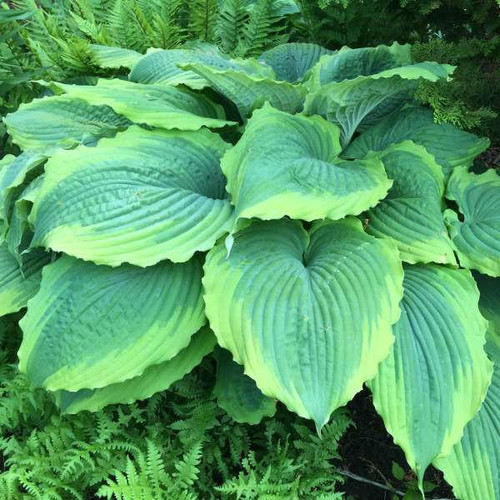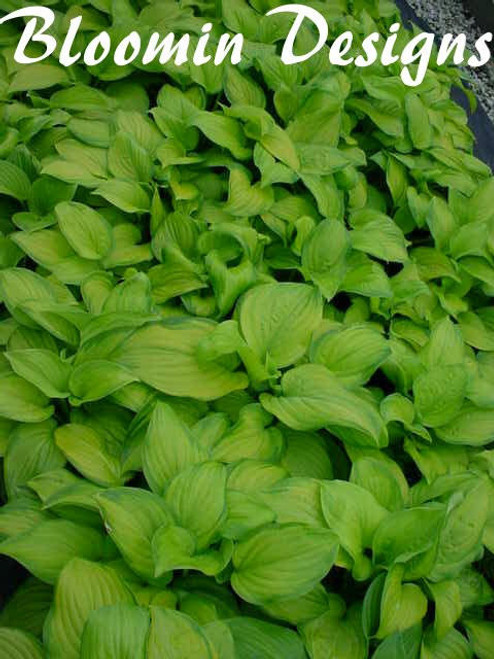Product Description
HALCYON Hosta (E. Smith / BHHS 1988) (25) Bare Root Plants
Medium.
Frosty blue, spear shaped foliage with
prominent veins and heavy substance.
Mature size - 23 inches wide x 21 inches height.
Thick, slug-resistant leaves.
Pale lavender flowers.
1987 American Hosta Society Distinguished Merit Hosta award.
sport of H. Tardiana grex.
Excellent color, substance and growth rate.
Hosta 'Halcyon' is a well-known hosta cultivar recognized for its blue foliage, vigorous growth, and resistance to slugs. It is a medium-sized plant that forms a dense mound, making it suitable for shade gardens. Here are its qualities:
Appearance:
- Blue-Green Leaves: 'Halcyon' has spear-shaped to heart-shaped leaves in a frosty blue-green shade with a slightly waxy texture, contributing to slug resistance.
- Lavender Flowers: In mid to late summer, it produces pale blue-violet flowers on 26 to 28-inch scapes (stalks) above the foliage.
- Mounding Habit: It forms a dense, mounding habit, typically reaching about 18 inches tall and 36 inches wide.
Growing Conditions:
- Shade: Thrives in partial shade to full shade, preferring some shade during the hottest part of the day to prevent leaf scorching.
- Moist Soil: Prefers moist, well-drained soil rich in organic matter.
- Hardiness Zones: Suitable for USDA hardiness zones 3-8.
Care:
- Watering: Requires regular watering, especially during dry periods, to keep the soil consistently moist.
- Fertilizing: Fertilize in spring with a balanced fertilizer to promote healthy growth.
- Mulching: Mulching around the plant helps retain moisture and suppress weeds.
- Dividing: Divide clumps every few years in spring or fall to maintain vigor.
- Uses:
- Shade Gardens: Adds presence to shade gardens.
- Borders: Can be used as a border plant or edging for pathways.
- Containers: Its compact size makes it suitable for containers on shaded patios or balconies.
- Woodland Gardens: Integrates into woodland gardens.
Additional Information:
- Slug Resistance: Exhibits good resistance to slugs, a common pest for hostas.
- Award Winner: 'Halcyon' has received numerous accolades, including the American Hosta Society Best Blue Leaf Award and the Distinguished Merit Hosta Award.
- Parentage: A hybrid of Hosta tardiflora and Hosta sieboldiana var. elegans, resulting in its blue foliage and vigorous growth.
Hosta 'Halcyon' is known for its blue foliage, good slug resistance, and reliable performance, making it a beneficial addition to any shade garden.
Other Details
The most important part of the plant is its root system. Healthy roots are the foundation of a healthy, vibrant plant. The type of plug container used is based on the specific needs of the plants. Perennials offered as bare root traditionally perform better when planted as bare root.Planted in a specialized mix, potted plants have well established root systems. Top growth stage will vary depending on the current life cycle and time of year when shipped. In Winter and early Spring dormant plants may be shipped. Dormant plants may be planted right away, even before the last frost date.
Most bare root varieties are field grown for at least one season, though Hemerocallis and Hosta are grown for two seasons. The bulk of the soil is removed during the harvesting process and the tops of most varieties are trimmed back to the crown. They are graded, packed in shredded aspen or sphagnum moss and stored in freezers until ready to be shipped.
See our Container Sizes and Bare Root Perennials pages for more information.
Plant information and care is provided in the Overview section, Plant Genus Page and general information is provided in the Planting Care & Guides. Additional questions can be asked on each Plant page.
Plant Spacing: Using the maximum mature spread or width of a plant to guide spacing, ensures space to grow to full size. To fill an area sooner, plant them closer together. Just remember, future thinning or transplanting may be needed.
Water: Keep a close eye on newly planted perennials, especially throughout the first growing year. Most early plant loss is due to too much or too little water!











